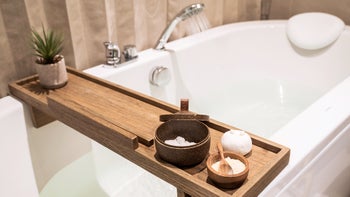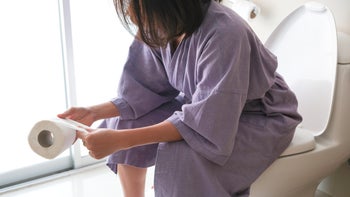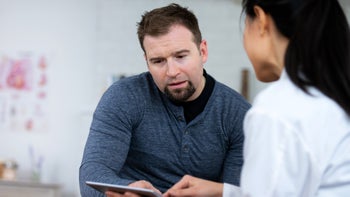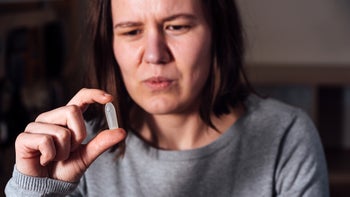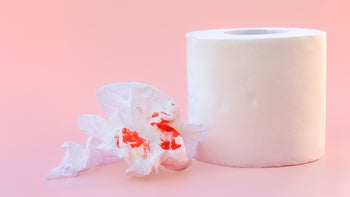
The Top 5 Ways to Get Rid of Your Hemorrhoids Fast
Key takeaways:
Swollen and inflamed hemorrhoids can be very uncomfortable. But there are several at-home remedies that can help you get rid of hemorrhoids.
Drinking more water and eating more fiber can help you get rid of piles and keep them from coming back. Over-the-counter (OTC) products can relieve symptoms fast, but the results are temporary.
Seek medical care if you have severe hemorrhoids or if they don’t get better with home remedies. Medical procedures are available for permanent relief.
Table of contents

Hemorrhoids are inflamed blood vessels inside or around the anus and rectum. They can cause uncomfortable symptoms like bleeding, itching, discomfort, and pain.
When you have hemorrhoid pain, you want relief fast. Hemorrhoids will usually go away on their own. But there are steps you can take to speed up healing and help relieve your symptoms. Here’s how to get rid of hemorrhoids and keep them from coming back.
What causes hemorrhoids?
Everyone is born with blood vessels in and around their anus and rectum. These blood vessels don’t cause problems unless they become swollen and inflamed. When that happens, hemorrhoids (also called piles) can develop.
Search and compare options
There are two types of hemorrhoids: external and internal.
External hemorrhoids develop on the outside of the anus, so you can feel them. A medical professional can diagnose them by examining your anus.
Internal hemorrhoids are on the inside of the rectum, so you usually can’t feel them. Sometimes, they may bulge out of the anus, but they can usually be pushed back inside. A medical professional can diagnose internal hemorrhoids using tools like an anoscope, proctoscope, or colonoscope.
Anyone can develop hemorrhoids. But you’re more likely to get them if:
You have constipation or strain during bowel movements
You’re pregnant
You have chronic diarrhea
You spend a lot of time sitting
Simple home remedies to get rid of your hemorrhoids
You should seek medical care if you have new rectal bleeding or blood in your stool. Hemorrhoids can cause these symptoms, but so can other medical conditions, like colon cancer.
If you already know you have hemorrhoids, you can try home remedies to ease your hemorrhoids before seeking care. Many hemorrhoids get better on their own within a week. Here are five ways to help them heal faster.
1. Drink more water
Constipation, or hard stool, is the most common cause of hemorrhoids. Low water intake can lead to constipation and make it worse. Try drinking more water each day. This will help soften your stools and make them easier to pass. Relieving constipation can help your hemorrhoids heal faster and keep them from coming back.
Soothing sitz baths: A sitz bath can be a comforting remedy for several conditions, including hemorrhoids. Learn more about its benefits and how to get the best results.
Pain-relief creams: If you’re dealing with itching, burning, pain, or swelling, hemorrhoid creams can offer relief. Here’s how to choose the right one.
Foods to avoid: What you eat can affect how quickly you heal from a hemorrhoid flare. Learn which foods to avoid — and which ones can help heal hemorrhoids and prevent future flares.
Plain water is the best way to stay hydrated. But any drink can help keep you hydrated. Just avoid alcohol, which can make you pee more and lead to dehydration and constipation.
If you’re not sure how much water you should drink each day, check with your healthcare team.
2. Eat more fiber
In general, most people can benefit from more fiber. The average person in the U.S. eats about 16 g of fiber daily, which is well below the recommended amount. The daily recommended amounts are 25 g of fiber for women and 38 g of fiber for men. Increasing how much fiber you have will help to treat constipation and improve hemorrhoids symptoms.
Many foods have fiber, such as different types of fruits and vegetables. There’s also fiber in nuts, beans, and whole grains.
3. Change your toilet habits
Whether you’re reading, playing on your phone, or just having a quiet moment, it’s easy to lose track of time on the toilet. But sitting for too long or straining on the toilet can make hemorrhoids symptoms worse. So, you want to minimize your time on the toilet.
A good rule of thumb is to remove all reading material from your toilet area. And avoid bringing your phone or tablet with you. Instead, focus on doing your business and get off the toilet quickly — without distractions.
4. Take sitz baths
A sitz bath is a nice and simple way to reduce hemorrhoids and ease uncomfortable symptoms. To take a sitz bath, soak your bottom in warm water for 10 to 15 minutes. You can do this in a bathtub or small plastic tub, which you can buy at the pharmacy.
You can take a sitz bath several times a day or as needed for relief. Warm water alone can help or you can use additives like Epsom salt.
5. Over-the-counter hemorrhoid medications
There are over-the-counter (OTC) medications that work fast to relieve hemorrhoid symptoms. But these medications won’t cure your hemorrhoids. Some options include:
Benzocaine (Americaine ointment) to numb pain
Witch hazel (Tucks Medicated Cooling Pads) to reduce swelling and pain
Witch hazel and phenylephrine combination (Preparation H Cooling Gel) to decrease irritation, and relieve itch, burning, and pain
Mineral oil, petrolatum, and phenylephrine combination (Preparation H) to decrease irritation, shrink swelling, and ease pain
Hydrocortisone (Preparation H Soothing Relief Anti-itch cream) to reduce inflammation and swelling
What hemorrhoid medication works the fastest?
OTC hemorrhoid medications can relieve your symptoms quickly. Here’s how quickly OTC products can work:
Benzocaine can relieve pain in as little as one minute.
Witch hazel can relieve itching and burning within a few minutes.
Phenylephrine will shrink hemorrhoids within 30 minutes.
Zinc oxide works right away to protect your skin over and around hemorrhoids.
Steroids will take several hours to relieve swelling and inflammation.
You may need to use more than one hemorrhoid medication to shrink swelling and ease burning, itch, and pain symptoms.
What can a healthcare professional do for hemorrhoid treatment?
It’s important to seek medical care if your hemorrhoids aren’t better within 1 week or if they get worse despite home remedies and OTC medications. You may need prescription treatments or medical procedures for your hemorrhoids.
Prescription medications
Your healthcare professional may recommend prescription suppositories, enemas, or topical creams. These can all help decrease the inflammation of your hemorrhoids. Common prescription treatments for hemorrhoids include:
Hydrocortisone medications (Anucort, Proctocort-HC, Proctocream) to decrease inflammation
Hydrocortisone plus lidocaine (Ana-Lex) to reduce inflammation and numb the area
Nitroglycerin ointment (Rectiv) to relax blood vessels that cause the hemorrhoids and treat pain in thrombosed hemorrhoids
Nifedipine ointment to relax the vessels in the hemorrhoids and reduce pain
Nonsurgical procedures
Several nonsurgical procedures can help manage hemorrhoids. These aren’t very invasive and include:
Rubber band ligation: Healthcare professionals usually perform this procedure in their office. They place a rubber band at the base of your hemorrhoids to cut off their blood supply. It’s only for internal hemorrhoids.
Sclerotherapy: For this procedure, a healthcare professional injects a chemical solution into the area around your hemorrhoids. This solution damages the blood vessels, causing them to shrink and scar down.
Electrocoagulation: This procedure uses an electric current to damage the hemorrhoids.
Infrared coagulation: This procedure uses an infrared light to quickly heat the blood vessels. This causes the hemorrhoids to clot and scar.
Minor internal hemorrhoids can usually be treated with medications and minimally invasive procedures like injection sclerotherapy or rubber band ligation. But you may need surgical treatment if your internal hemorrhoids are severe or other treatments don’t work.
Surgical procedures
Surgical procedures are typically performed in the operating room with some form of anesthesia. They can work for both internal and external hemorrhoids. Surgical treatments for hemorrhoids include:
Hemorrhoidectomy: This procedure requires a trip to the operating room to cut out and remove the hemorrhoids. It’s the most effective method of treating hemorrhoids.
Hemorrhoid stapling: In this procedure, a healthcare professional staples and removes the hemorrhoidal tissue. This is also performed in the operating room.
How long does it take for hemorrhoids to go away?
How long it takes for hemorrhoids to go away depends on their severity. Minor hemorrhoids may go away on their own in just a few days. More severe hemorrhoids may take months to improve.
Complicated hemorrhoids may not go away, even if you follow all the recommendations and use home remedies or prescriptions. If they don’t heal and continue to cause problems, you may need surgical hemorrhoid removal.
Frequently asked questions
Witch hazel products for hemorrhoids are available in cream, wipe, and liquid form. Apply witch hazel cream directly to your hemorrhoids and read the product label to know how often you can apply it. Witch hazel wipes can be used as needed for discomfort or after a bowel movement. Gently pass a new wipe over your hemorrhoids. To use witch hazel liquid, moisten a new cotton ball and gently dab it on your hemorrhoids.
Ice packs can temporarily relieve or reduce hemorrhoid symptoms. Wrap ice cubes, reusable ice packs, or cold gel packs in a clean towel and place it over your hemorrhoids for 15 to 20 minutes. The towel will help protect your skin from cold injury. Some gel packs are marketed specifically for hemorrhoids and provide the same relief as other ice packs, but are small and easy to place on your hemorrhoids.
The bottom line
Hemorrhoids can cause uncomfortable symptoms like bleeding, itching, or discomfort. At-home treatments can be a simple way to help decrease the symptoms of hemorrhoids. Changing your diet, improving your toilet habits, and drinking more water can help relieve hemorrhoids and keep them from coming back. OTC medications can also help relieve symptoms fast.
Why trust our experts?


References
Anti, M., et al. (1998). Water supplementation enhances the effect of high-fiber diet on stool frequency and laxative consumption in adult patients with functional constipation. Hepato-gastroenterology.
Bliss, R. (2015). Online nutrition resources at your fingertips. U.S. Department of Agriculture.
Blistex. (2024). Tucks medicated cooling pads- witch hazel solution [package insert]. DailyMed.
Haleon US Holdings. (2024). Preparation H cooling gel- phenylephrine HCL, witch hazel gel [package insert]. DailyMed.
Haleon US Holdings. (2024). Preparation H- mineral oil, petrolatum, phenylephrine HCL ointment [package insert]. DailyMed.
Haleon US Holdings. (2024). Preparation H soothing relief anti-itch- hydrocortisone cream [package insert]. DailyMed.
InformedHealth.org. (2017). Enlarged hemorrhoids: How can you relieve the symptoms yourself? Institute for Quality and Efficiency in Health Care.
Insight Pharmaceuticals. (2024). Americaine- benzocaine ointment [package insert]. DailyMed.
Lisi, G., et al. (2022). Sclerotherapy for III- and IV-degree hemorrhoids: Results of a prospective study. Frontiers in Surgery.
MedlinePlus. (2017). Hydrocortisone rectal.
MedlinePlus. (2023). Hemorrhoid surgery - series—procedure.
Mott, T., et al. (2018). Hemorrhoids: Diagnosis and treatment options. American Family Physician.
National Institute of Diabetes and Digestive and Kidney Diseases. (2016). Definition & facts of hemorrhoids.
Perrotti, P., et al. (2001). Conservative treatment of acute thrombosed external hemorrhoids with topical nifedipine. Diseases of the Colon and Rectum.
Richards, E., et al. (2023). Phenylephrine. StatPearls.
Sun, Z., et al. (2016). Review of hemorrhoid disease: Presentation and management. Clinics in Colon and Rectal Research.


